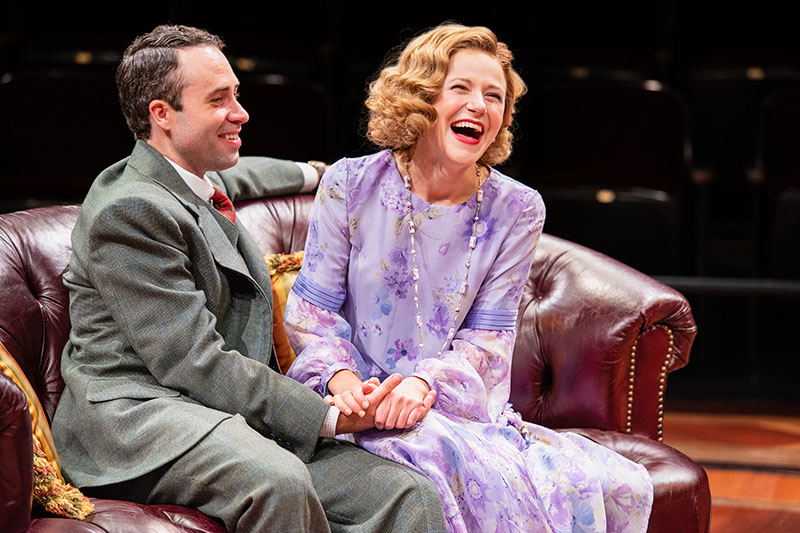Culture
 Baize Buzan (Linda Seton) in "Holiday." Photo by Margot Schulman.
Baize Buzan (Linda Seton) in "Holiday." Photo by Margot Schulman.
Well-Heeled: Costumer Ivania Stack Brings the Glam to Arena Stage’s “Holiday”
October 21, 2022 @ 10:00am
From 17th century queens to 21st century zombies, costumer Ivania Stack has seen and dressed them all. Even the most casual D.C. theatergoer should know her work, which has appeared in over 200 productions at over 40 theaters, from the District’s own Arena Stage to Woolly Mammoth, alongside companies such as Theatre Alliance, GALA, and Rorschach, as well as major regional theaters up and down I-95.
Now, the prolific Stack—a George Mason and UMD alumna and Georgetown faculty member—has designed desirable drop-waist dresses and well-cut wool suits for Arena’s revival of “Holiday” (running through November 6), Philip Barry’s 1928 satire of the upper crust and those with seemingly pie-in-the-sky dreams of living an examined life.
District Fray: Have you designed a show set in the 1920s before?
Ivania Stack: I’ve done a little bit of work on shows set in the 1920s, but not exactly like this, the high society, fashionable ’20s, and often at theaters where I didn’t necessarily have the full, wondrous might of the costume shop at Arena. It was me going to thrift stores and making dresses look more ’20s, adapting and figuring it out. That was such good experience for me doing this piece.
What are some of the hallmarks of ’20s fashion?
It’s sort of a rebellion from the previous eras, Victorian and the ‘teens, the flu epidemic that happened previously. The young people are partying. Everything in fashion is a reaction to something else.
It’s a tricky period because it’s so specific. Even more than the ’40s or ’50s, or even the ’30s, the ’20s are more contemporary-looking because of the riskiness of the clothes. The hemlines are shorter. We’re losing sleeves left and right (laughs). There’s something really lovely about the idea that women were like, “I don’t want to wear all that stuff. I want to be freer.”

Sean Wiberg (Johnny Case) and Olivia Hebert (Julia Seton) in “Holiday” running October 7 through November 6 at Arena Stage at the Mead Center for American Theater. Photo by Margot Schulman.
A lot of us will have well-defined ideas about 1920s clothes from films like “The Great Gatsby” and “Chicago.” How did you research what people actually wore?
I really love to look at actual garments from the period as much as possible, especially knowing that we were going to build a lot of garments, including suits.
With this particular play, because the characters are a wealthy New York family, you can find examples of their dresses [easily]. The Met publishes beautiful photographs of their collection from the 1920s, evening gowns and even day dresses.
You can look overseas at the Victoria and Albert Museum because in New York they may have been emulating some of those styles from France and England and the Royal Family. You can look at what butlers wore in England and then it’s fun to try to figure out how they might adapt it for the United State.
This play opposes two approaches to life: capitalist or a kind of transcendentalist. How did you approach the more progressive characters?
I have this wonderful book that my husband gave me 20 years ago called “Art Deco Fashion.” It shows art deco paintings and art and then the comparative version in clothing. So for the more avant-garde sister and her friends I looked there for inspiration, as opposed to more traditional floral fabrics or something like that.
There’s a reference in act two when there’s an older, more traditional party happening downstairs, and the younger sister is throwing this wilder party upstairs. One of the family friends in this silly, very floofy, very pastel dress with a huge bow comes in and sees someone in this “twin bed jacket from Hammacher Schlemmer,” who sold industrial parts. The playwright gives you these comedic clues that you then have to dig into. Instantly, I was like the upstairs party is metallic and kind of funky. Maybe they created their clothes for this party. This tells me something about the two different worlds happening in this scene. The clashing of younger and older, avant-garde and traditional is a recurring theme in the play.
Speaking of story and theme, how did you work with director Anita Maynard-Losh and the actors?
Anita did this deep dive into the text. In early conversations, she drew my attention to certain things about the script and the characters. She wasn’t like, “It has to be this, this, and this.” She set me on a path and then I was able to amass tons of research and bring it back to her to identify what felt most right for the characters. So from the start, we’re on the same page.
I love to get actors involved as early as possible. When you’re building a show, there’s a little bit of thinking ahead. What do the actors need in terms of movement? In terms of comfort? What am I kind of prescribing for their character?
Then, I have conversations with them, especially in the fitting. In those, you can show them the fabrics and ask about comfort and movement, but also what you are thinking about their character, the kind of journey you are taking the character on and how they feel about that. Sometimes I will adapt a design. I always see fittings can be very much an extension of the rehearsal room, as long as you invite questions and conversations.
The last thing I want to do is have actors come in and feel like they have this thing put on them, that it is like an alien thing that I have decided to put on them and then it’s like, “Get out there. Do your thing.”
“Holiday” runs at Arena Stage through November 6.
Arena Stage: 1101 Sixth St. SW, DC; arenastage.org // @arenastage







